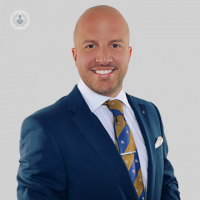How does shockwave therapy treat erectile dysfunction?
Autore:Erectile dysfunction occurs when the man is unable to achieve or maintain an erection, and is, unfortunately, quite the common condition. Fortunately, however, there are now highly effective treatment options for this relationship-affecting problem, with shockwave therapy being one of them.
On hand to explain exactly how a typical shockwave therapy procedure is carried out, and how it helps treat erectile dysfunction, is highly experienced consultant urologist and andrologist, Dr Fabio Castiglione.

What is low-intensity shockwave therapy for erectile dysfunction, and how is the procedure carried out?
Shockwave therapy is the latest therapeutic modality for patients suffering from erectile dysfunction. Its therapeutic action improves spontaneous erections and also has the ability to invigorate and rejuvenate the erection mechanism.
Shockwave therapy works by means of acoustic waves that generate a pressure pulse and carry energy when they propagate through an element. When shock waves are applied to an organ, the focused waves interact with the chosen deep tissues and act as transient micromechanical forces that induce biological changes in the cells of the blood vessels and reduce the fibrosis.
In the specific case of erectile dysfunction, shock waves improve erection by means of two mechanisms. Firstly, it promotes neoangiogenesis (the formation of new blood vessels) in the penis, thus increasing the flow of blood and thus allowing for more vigorous erections. Secondly, it induces invigoration and rejuvenation of the smooth muscle of the penis, reducing fibrosis.
What qualifies a patient for this treatment?
In theory, shockwave therapy can help all patients suffering from erectile dysfunction and even improve erection in men who do not have any problems of this type, so much so that it can be used as a prevention for erectile dysfunction. A complete diagnostic evaluation before proceeding with treatment is important to determine the optimal therapeutic protocol.
How often should patients have the treatment, and how long does each treatment last?
Before accessing this type of treatment, patients must always see a specialist. It is an absolutely safe, painless, and effective treatment without drugs or surgery, providing long-term results.
The procedure relies on low-intensity, high-frequency sound waves, so the most the patient experiences is a barely noticeable slight tingling sensation. During the procedure, the doctor covers a special probe of the apparatus with gel and guides it over various areas of the penis.
Treatment sessions can last anywhere from 15 to 20 minutes. The number of sessions ranges from six to 18, depending on the severity of the erectile dysfunction case. As mentioned, access to therapy is established following a specialist visit.
How effective is the low-intensity shockwave therapy in treating erectile dysfunction?
A growing body of scientific evidence shows that shockwave therapy for erectile dysfunction can be extremely useful in patients who suffer from mild or moderate erectile dysfunction and who respond well to PDE-5 inhibitors. Shockwave therapy in combination with any other therapeutic modality improves the results.

Are the results permanent?
The effects of shockwave therapy are permanent and this is demonstrated by various published scientific evidence. However, erectile dysfunction is also caused by the patient's lifestyle. The improvements induced by shockwave therapy can undergo a reversal over time if the underlying problems are not resolved.
What should be done if the therapy does not work?
Patients usually respond well to shockwave therapy, but it may take a few months to achieve maximum effect. If, after three or four months, the patient still does not show a significant improvement, other therapeutic modalities are considered.
Are there any side effects? If so, what are they?
Following exposure to shockwave therapy, the following improvements are observed:
- the microcirculation in the tissues is accelerated
- the metabolic rate increases
- local immunity is activated
- increased oxygenation
- tissue regeneration is accelerated
- collagen production is stimulated to restore the elasticity and structure of the ligaments
- chronic inflammatory processes are eliminated
- histamine and other irritating elements are excreted
- blood circulation improves
Does shockwave therapy cause pain?
Penis pain and penile bruising are common side effects of shockwave therapy for erectile dysfunction. Occasionally, the onset of veno-occlusive vascular insufficiency has been reported under the influence of shockwave therapy.
However, the treatment is generally very well-tolerated by patients. Shockwave therapy for erectile dysfunction is not necessarily a lifelong treatment. Often, one course of treatment over a period of three months provides a long-term improvement in erectile function without the need for continuous treatment. Periodic repetition of treatment as part of maintenance therapy may be helpful.
Dr Fabio Castiglione is a mightily skilled London-based consultant urologist and andrologist who is an expert when it comes to shockwave therapy. If you are currently suffering from erectile dysfunction, you can consult directly with Dr Castiglione by visiting his Top Doctors profile today.


